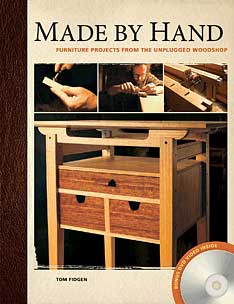 Do you enjoy woodworking but would like to be “green” about it? Would you love to create nice looking pieces with a minimal number of tools? Would you like the lumber yard to be your back yard? A “yes” to any of these questions could mean a look into the usage of bamboo. “The Craft and Art of Bamboo” by Carol Stangler, available at Highland Woodworking, proves this sturdy, fast growing plant can make more than just a fancy fence or décor in a tiki-themed resturant. While primarily associated with Asian craft, bamboo grows equally well in North as well as South and Central America, and has been used for everything from drinking vessels and flower vases to counter tops and fishing boats!
Do you enjoy woodworking but would like to be “green” about it? Would you love to create nice looking pieces with a minimal number of tools? Would you like the lumber yard to be your back yard? A “yes” to any of these questions could mean a look into the usage of bamboo. “The Craft and Art of Bamboo” by Carol Stangler, available at Highland Woodworking, proves this sturdy, fast growing plant can make more than just a fancy fence or décor in a tiki-themed resturant. While primarily associated with Asian craft, bamboo grows equally well in North as well as South and Central America, and has been used for everything from drinking vessels and flower vases to counter tops and fishing boats!
Stangler’s self admitted love of bamboo comes through with the care and depth found in each section, beginning with a brief overview of how the plant is grown and used throughout the world before moving on to practical harvesting practices and the tools required to cut and work the material. A number of modern furniture designers were pulled in for input on some of the larger projects, which brings a variety and a stylishness to the pieces. While many are understandably Eastern in inspiration, that is certainly not the case with all of the projects, and the novice woodworker is not left out with simple designs like drinking cups, snack trays, or a doormat that are still attractive and eco-friendly while requiring only a few tools.
 Many woodworking books fall under two distinct categories, the inspirational, giving us food for thought or highlights of a particular vein of woodworking, or the the more practical, providing hands-on step by step guidance. A book that straddles that line is Made By Hand by Tom Fidgen, published by Popular Woodworking Books. Fidgen belongs to the class of woodworker that eschews the realm of power tools to focus exclusively on hand tools. Rather than try and convince readers that his method is best for all, Fidgen writes of how the decision to work with hand tools was first a practical one followed then by a sense that they allowed him greater freedom to express his ideas.
Many woodworking books fall under two distinct categories, the inspirational, giving us food for thought or highlights of a particular vein of woodworking, or the the more practical, providing hands-on step by step guidance. A book that straddles that line is Made By Hand by Tom Fidgen, published by Popular Woodworking Books. Fidgen belongs to the class of woodworker that eschews the realm of power tools to focus exclusively on hand tools. Rather than try and convince readers that his method is best for all, Fidgen writes of how the decision to work with hand tools was first a practical one followed then by a sense that they allowed him greater freedom to express his ideas.
His work, as displayed in several cabinets detailed throughout the book, shows a design aesthetic informed by the simplicity of Japanese cabinetry as well as the work of renowned woodworker James Krenov. With an easy to read writing style, Fidgen describes his work, not as a retrospect from decades of experience, but rather as “recent adventures” detailing the trials and tribulations of a burgeoning woodworker.
Spurred on by concerns of shop space and a need to feel more “natural” in the process of working with wood, Fidgen writes at length about the setting up of a comfortable shop space, not just in terms of size requirements, but also in putting thought to the flow of work. He also goes into detail about the various tools that he feels are indispensable. Stalwarts such as various hand planes, hand drills, and marking gauges are discussed, both in terms of the importance of acquiring good tools to start with, and the uses that may or may not be obvious to the beginning woodworker.
Moving past the tools themselves, the discussion moves to the selection and preparation of wood as well as various ways of marking and measuring the selected wood for the task at hand. From there the topic moves to joinery methods he prefers, such as the dovetail joint, and the use of mortise and tenons. The practical application of these methods are featured in six well designed cabinets of various size and function, with detailed text and pictures outlining their construction.
While recognizing the practicality of the skill of woodworking, Fidgen writes freely about the peace of mind he gets from his craft, giving voice to the concern of “why” woodworking traditions continue, not just the “how-to” aspect. While one could reproduce any of these cabinets from the text and pictures provided, one feels the real meaning behind this book is to inspire other woodworkers to find their “voice” in their craft. Made By Hand belongs in the library of any woodworking school, and on the shelf of anyone wishing a bit of inspiration, and a lot of practical know-how.
 Few things let us see the personality of a woodworker like a view into their shop. The design, use and upkeep of a shop gives an odd insight to how a person approaches their work. Providing a unique and personal view into the variety of shops found around the United States is “Woodshop Lust”. The book is split up into three sections, the garage based shop, the basement shops, and the stand alone buildings. For all the commonalities in the tools we all use, clamps, drills, saws, “Woodshop Lust” displays a wide variety in how we outfit our work area, from the meticulous organization of Walt Grannen’s in Wisconsin to the more chaotic but still efficient shop of Jim Stack of Ohio, and from the rustic and industrial, to Ray Merrell’s adobe inspired domed Colorado shop.
Few things let us see the personality of a woodworker like a view into their shop. The design, use and upkeep of a shop gives an odd insight to how a person approaches their work. Providing a unique and personal view into the variety of shops found around the United States is “Woodshop Lust”. The book is split up into three sections, the garage based shop, the basement shops, and the stand alone buildings. For all the commonalities in the tools we all use, clamps, drills, saws, “Woodshop Lust” displays a wide variety in how we outfit our work area, from the meticulous organization of Walt Grannen’s in Wisconsin to the more chaotic but still efficient shop of Jim Stack of Ohio, and from the rustic and industrial, to Ray Merrell’s adobe inspired domed Colorado shop.
“Woodshop Lust” also covers some of the creations that come out of these shops. Some leaning more to the artistic, others more utilitarian, it’s fun to see how the work reflects these personalities along with the spaces that spawned them. Whether your shop displays sports memorabilia or old road signs or is a stark monument to efficency, editor David Thiel invites readers to send in pictures of their own shops, with a promise of further volumes of “Woodshop Lust” to come.
“Woodshop Lust” is available to buy at Highland Woodworking.
